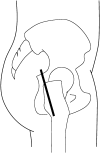Mini-incision posterior approach for total hip arthroplasty
- PMID: 15168084
- PMCID: PMC3456936
- DOI: 10.1007/s00264-004-0570-1
Mini-incision posterior approach for total hip arthroplasty
Abstract
We compared the short-term outcomes of 50 total hip arthroplasties performed through a mini-incision posterior approach with those of 42 arthroplasties performed through a conventional posterior approach. There were no significant differences in age, gender, and bodymass index between groups. The mean operative time was shorter (99+/-26 versus 123+/-30 min), and the peroperative mean blood loss was smaller with the mini-incision (339+/-210 versus 422+/-177 ml). There was no significant difference between groups in post-operative mean blood loss, mean inclination angle of acetabular components, percentage of hips with good inclination angle, and mean hip score at 6 months after surgery. There was one infection in the conventional group but none in the mini group. There were no dislocations or symptomatic pulmonary embolism in either group. With the mini-incision posterior approach, surgical invasion was reduced, and short-term outcome was as good as with a conventional posterior approach.
Nous avons comparé les résultats à court terme de 50 arthroplasties totales de la hanche exécutées à travers une approche postérieure par mini-incision avec ceux de 42 arthroplasties exécutées à travers une approche postérieure conventionnelle. Il n’y avait pas de différences notables dans l’âge, le genre, et l’index de masse corporelle entre les groupes. Le temps opératoire moyen était plus court (99±26 contre 123±30 min) et la perte moyenne de sang plus faible avec l’incision mini (339±210 contre 422±177 ml). Il n’y avait aucune différence notable entre les deux groupes dans la perte de sang moyenne postopératoire, l’angle d’inclinaison moyen des composants acétabulaires, le pourcentage de hanches avec un angle d’inclinaison correct, et le score moyen de la hanche six mois après la chirurgie. Il y avait une infection dans le groupe conventionnel, mais aucune dans le groupe mini. Il n’y avait pas de luxation ni d’embolie pulmonaire symptomatique dans l’un et l’autre groupe. Avec l’approche postérieure par mini-incision, la chirurgie a été moins invasive et le résultat à court terme aussi bon qu’avec une approche postérieure conventionnelle.
References
Publication types
MeSH terms
LinkOut - more resources
Full Text Sources
Medical


